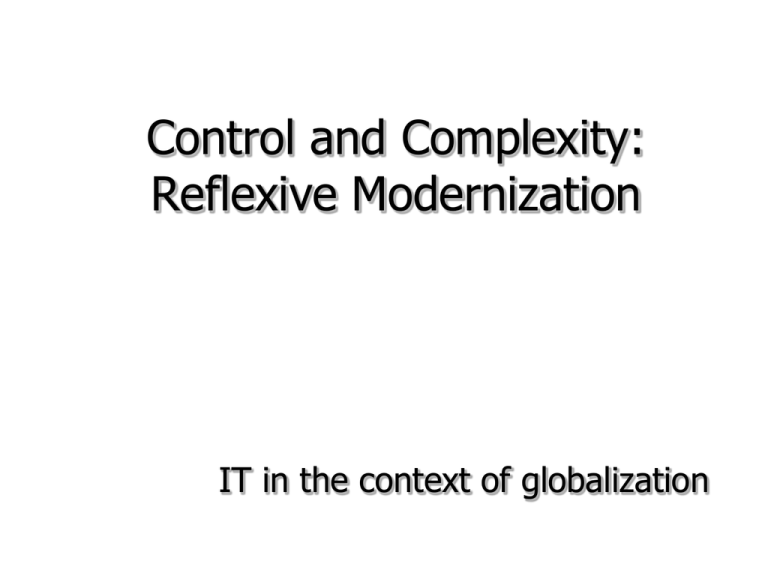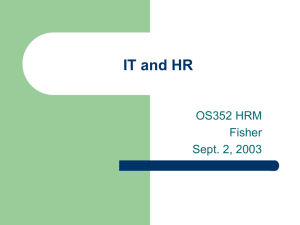Bootstrapping Network Technologies
advertisement

Control and Complexity: Reflexive Modernization IT in the context of globalization Control/Risk • Traditional SE/IS methods (and management • • models) have control as objective Beniger: The Control Revolution (“=modernity”) Limits to control: complexity/side-effects – Novelty, conflicts • Installed base? Technology as autonomous agent • Globalization • .. • Risk = NOT Control Globalization and modernity • Modernity • From 1700 – Aim: Increased control – Institutions (Giddens): • Rationalization, control systems • Industrial society, capitalism, .. • = Science and technology – Essence (Giddens): • time-space distansiation • development of “disembedding mechanisms” – symbolic tokens (money, .. (information?)) – “expert systems” (professions, professional knowledge,..) • reflexive appropriation of knowledge • Modernity = NOT Tradition Globalization a la Ulrich Beck • Risk Society • Reflexivity – Self-reflection – Feed-back • Globalization of side-effects • Increased unpredictability, less control • “Side-effects and non-knowledge are the main driving forces in today's’ society” The risk profile of modernity • Globalization of risks in terms of intensity (the bomb) • … number of factors we are influenced by depends of global division of labour • Risk from our constructed environment (technoligization of nature) • Institutional risk (”black Monday”) Aspects of “risk society” • Effects of side-effects generally • More integrated technological (sociotechnical) systems => technology becomes more autonomous • Patterns of side-effects – Network externalities is one form of side-effects – Self-reinforcing processes (adoption of standards) – Propagation of side-effects: domino-effects, boomerang-effects = reflexivity General pattern • Integration to increase control (of complex processes) • Integration increases complexity • = managing complexity by increasing complexity • => less control Cases • Hospital: EPR • Telecom (Mobile): Billing • Bank: Global e-mail infrastructure • Ship classification: In house dev. “ERP” • Pharmaceutical: Intranet • Computing • Metal industry • Chemical industry/conglomerate Strategies • Rationalization, modernization • The role of IT infrastructures • Effects: Control? • Technology out of control? Complexities Reflexive Integration/Standardization: Electronic Patient Records • Aim (1995): – – – – One integrated patient record One integrated system Norwegian standard Better and safer patient treatment • Result? Making a standard => Killed it • The beginning: 5 Norwegian regional (and university) • • • • • • • hospitals + “global” vendor Integrating data across specialities/units and hospitals Integration with infrastructure (computers, OS, network, ..) Integrating practices within and across hospitals Integrated with Siemens products and strategies Globalized the project (Scandinavia, Europe, India, US, ..) Slow progress – competing products emerged Health care reform in Norway: Regional standards Getting rid of paper =>More paper • After 8 years: 20-30% of info electronic • Lots of “air” in printouts • Electronic lab reports – up to 14 paper copies One integrated system => More systems • From 5 to 134 “EPR systems” – “One patient – one record” order creates dis-order • IVF: father and mother • Birth: Mother & child • …. – specialist systems (the wider the scope, the lower usability) – Instruments which include “EPR’s” –… Integrated patient record => More fragmentation • More ”EPR-s” • More paper => – Poorer access to paper record – Crises in the archive • Crises!! • Scanning? also added to the complexity Patient risks? • http://www.nrk.no/nyheter/distrikt/nrk_trondelag/1.622219 • Krisemøte på St.Olavs • Datasystemet ved St Olavs Hospital er ute av drift. Alle de nye • • • • sentrene står uten både interntelefoner og datasystemer. Av Elisabeth AasPublisert 20.06.2006 09:54 Problemene begynte å tårne seg opp i går kveld, før systemet kollapset i løpet av natta. Nær halve sykehuset er uten datanett. Både øre-nese-halsavdelingen, slagenheten og laboratoriessenteret er satt ut av spill som igjen påvirker primærleger. Konsekvensene ved datasvikt er omfattende.Pasientlistene fungerer ikke på grunn av data-problemene, journalsystemet er nede og telefonsamtaler til og fra avdelingen er ikke mulig. New strategy • 2003-2004: Portal • Also quite complex …. •? Reflexivity: Global Bank • • • • • • • System risks, “near disaster” Ongoing growth and integration Variety of e-mail systems, services, practices E-mail: from instant messaging to business critical archive One integrated e-mail system, one integrated and centralized support organization Integration of cultures? Bank Holiday Shutdown – – – – – The system didn’t boot: to much e-mail Booting locally, restoring back-ups Access rights: full rights to everybody Global access to sensitive information Booted after a week Reflexivity: Mobile Phone Billing • Australian company went bankrupt • Rapid growth and change over many years – Customers, employees, services, telecom infrastructure, IT infrastructure, ISs, .. – Going global: expatriates • Consultancies, outsourcing • Communication – Matrix – More consultancies: mixture of methods, hiding info. • Risk Management – Many risks .. To many: complex system in itself – Avoiding blame – “Risk Shuffling” (distribution of “bads”) Norsk Hydro • Established 1907 • Fertilizer • Light metals, oil and gas • Rapid expansion 75 - 86 • Independent national companies • 92: Crisis - decided tight integration in Europe Phase 1: Reengineering - no IT • Plan: Fast integration into “One Single European Learning Organization” • Change agents from the middle - “showed the door” • No result • Extremely heterogeneous IT - decided to go for SAP 2: SAP Pilot - Involving locals • Started developing unified SAP solution • Involving locals • Pilot installations • Change process started to move • SAP - important change agent -allied with top management 3: Fragmentation Validation/implementation • Validated the SAP pilot - specifying additional local requirements • Identifying and implementing shared services • Fragmentation of SAP solution • From unified common system to heterogeneous infrastructure • SAP becomes allied with the locals 4: Corporate infrastructure Future organizational change • Integrated with other SAP solutions • Integrated with underlying infrastructure and other applications • No design - no plans: Emergent infrastructure • “SAP is like concrete” • Blocks future changes? • SAP becomes independent master? Hydro Bridge • Increased focus on collaboration and learning • • • • • across divisions Office support, e-mail, Notes, Internet/Intranet Heterogeneous organization -> heterogeneous systems (functions, versions, …) integration – local infrastructure – other applications (SAP, SUN, ….) Standard crumbles – out of control SAP integration: Bad support as side-effect The changing roles of IT • From shared, unified system to complex, heterogeneous corporate infrastructure • Roles (Who is in control?): – Blocks change – Helping top management – Helping locals – Independent master? IBM • Introducing CRM (Customer Relationship Management) • Unified and integrated “interface” to all “products” (PC’s, big computers, support, facilities management, strategic/management consulting,...) • 120.000 affected world wide • Driven by top management IBM, cont. • Top-down, radical reengineering • IT: Planned total redesign, later focus on a few Lotus Notes applications • Huge problems, small (no?) effect • Problems: Complexity and dynamics, existing IT-systems (thousands) • Installed base (irreversible, out of control) SKF • Ball bearings (22.000), 1907, 43.000 employees, 20% of world market • National subsidiaries up to app. ’78 • One integrated organization • Global SNA network • Common systems (logistics, distribution, sales, production, ..) SKF • Centralized, stable, low learning, closed • Increased collaboration with customers (Ford) • Service oriented products (surveillance systems: motor factory, oil refinery) • Success because: – Loosely coupled (un-modern) – isolated, stable world Hoffman-LaRoche • 6. largest within pharmaceuticals • Support for “Strategic marketing” • MEDNET – Design from scratch, expensive, failure, stopped Internet/Intranet • Separate solutions for each unit (“therapy”, • • • • country) Close collaboration with externals (doctors, researchers, patients, ..) Informal collaboration across units No control, plan, strategy (“financed” as SAP related) Success because: allied with one powerful actor, following this Could the risks have been managed? • Predicted? • Would ”best practise” make a difference? – Spiral model/prototyping?





